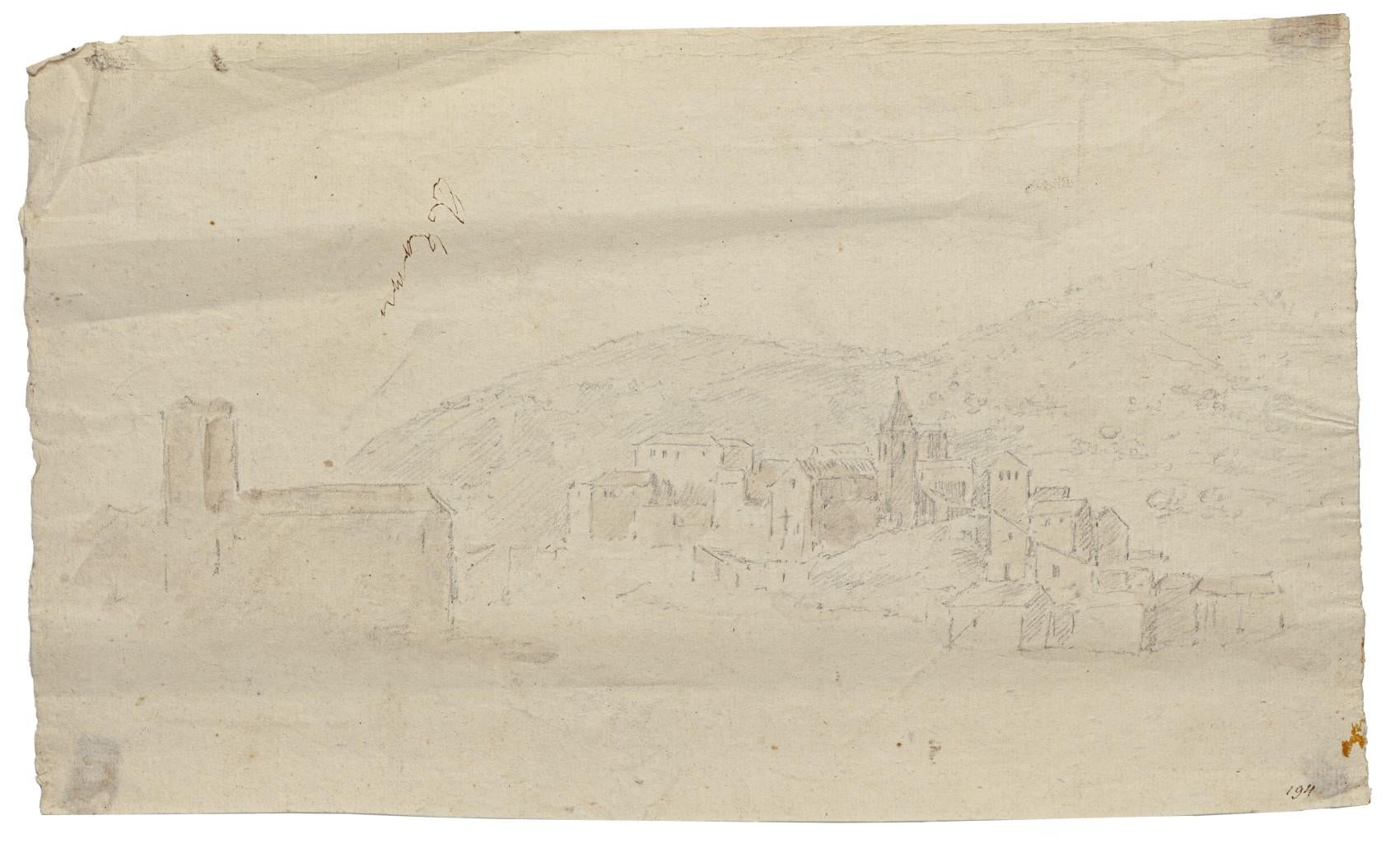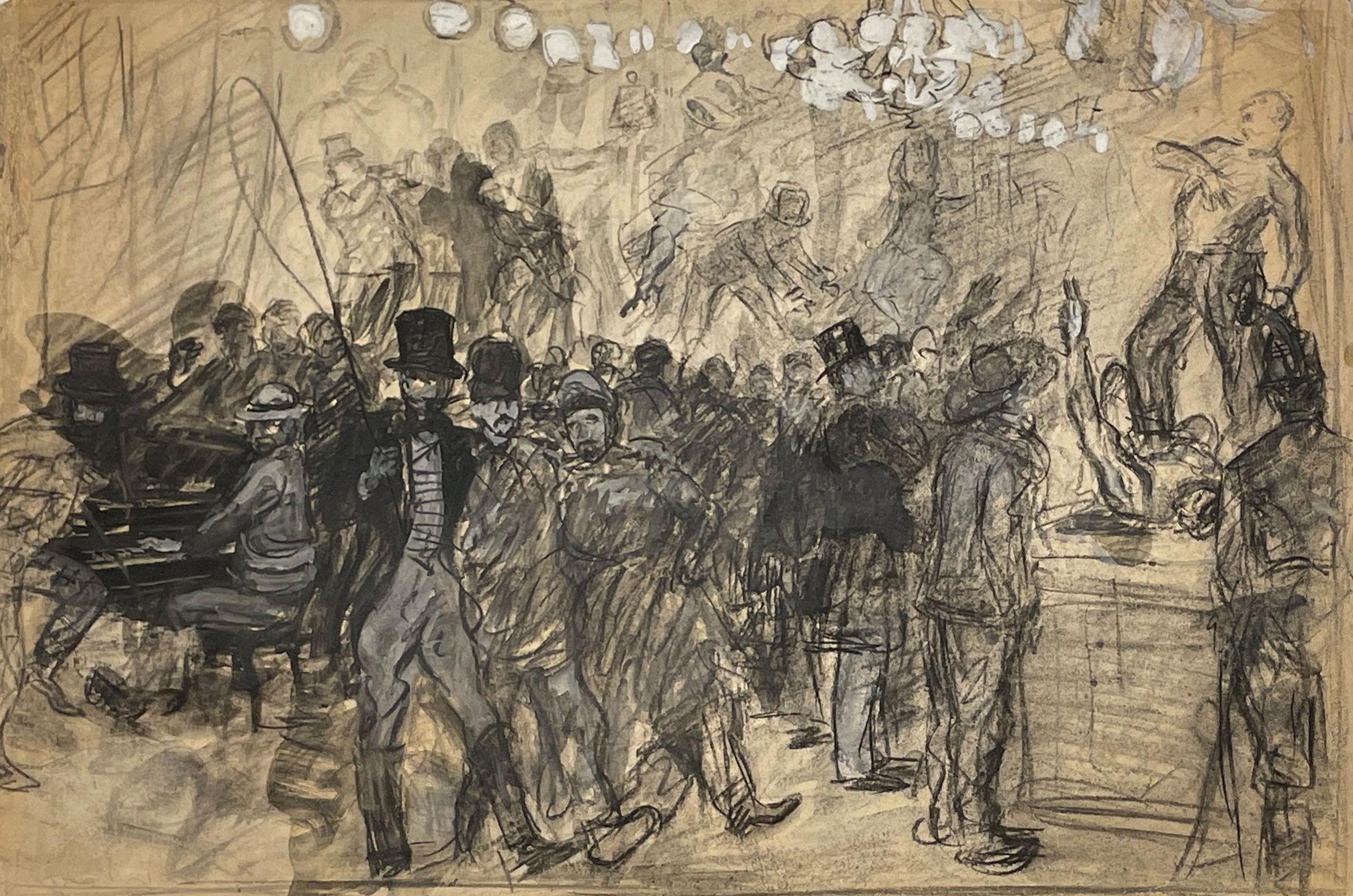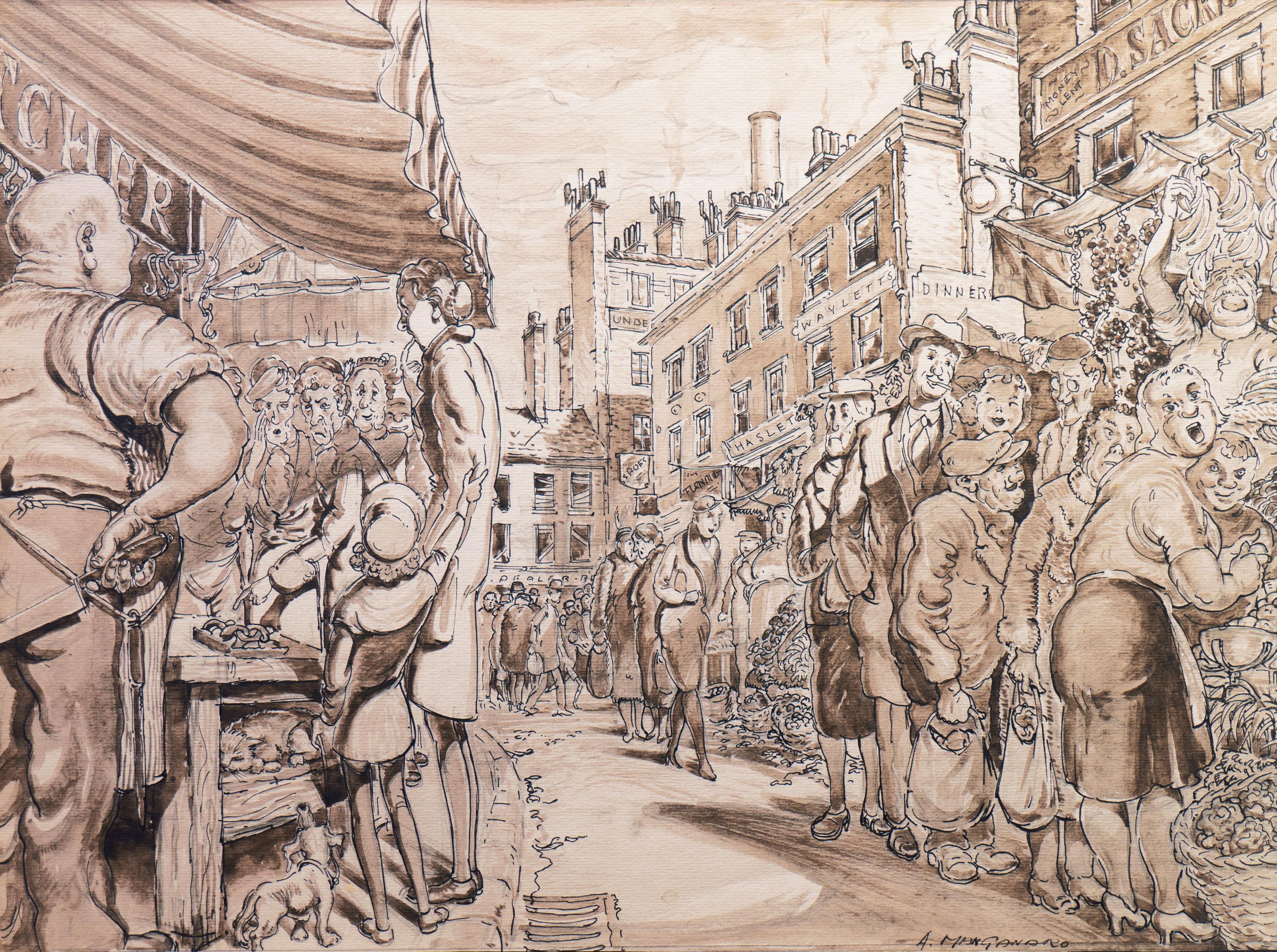Items Similar to Portrait of a Slave Ship: 'Le Negrito à l’ancre. Dans le port de la havanne'
Want more images or videos?
Request additional images or videos from the seller
1 of 2
François Mathurin Adalbert, Baron de CourcyPortrait of a Slave Ship: 'Le Negrito à l’ancre. Dans le port de la havanne'1832
1832
About the Item
FRANÇOIS MATHURIN ADALBERT, BARON DE COURCY (1805-1839)
'Le Negrito à l’ancre. Dans le port de la havanne'
Indistinctly signed lower left
Titled on the mount
Pencil and watercolour, heightened with white, on paper, 24.8 x 34.6 cm
Literature:
The present watercolour will be illustrated in:
- Prof. Manuel Garcia’s projected book on the disease and the slave trade provisionally titled “Fighting the Yellow Demon of Fever: The Struggle against Disease in the Illegal Slave Trade”.
- Prof. Micael Zeuske’s forthcoming Global history of slave trade.
Exhibited:
Mexico City, 1998, Palacio Virreinal, El Barón de Courcy, illustrationes de un viaje, 1831-1833, no. 108
Note:
Baron de Courcy was in the Caribbean in late 1832 and early 1833, following his tour of Mexico in 1832, on the last leg of his “Grand Voyage Américain” which had begun with the eastern seaboard and waterways of Canada and the United States in 1831. He had sketched the great natural wonders of the New World en route, from Niagara Falls to the Mexican sierra, but the present watercolour of the slave ship Negrito is undoubtedly the most arresting of all of his American paintings.
De Courcy paints the deck of the ship, where some of the slaves, probably mainly the women, were sheltered beneath spare furled sails when the ship was anchored. When sailing the slaves were stowed in the lower decks and only when these were completely full some had to stay on loose boards above the water running across the deck.
This watercolour places De Courcy in Havana in December 1832, as the Negrito is recorded as arriving in the port with its “cargo” on 11 December 1832. The details of the slaver’s voyage are recorded in detail on the “Voyages” list in “The Trans-Atlantic Slave Trade Database”.
The Negrito, captained by Francisco Antonio Sarria, flying the Spanish and Uruguayan flags, sailed from Havana for the west coast of Africa on 17 June 1832. She made landfall at Whydah (Ouidah) in the Bay of Benin and departed from Africa on 20 October with 590 slaves, bound for Havana. The passage took fifty-two days, with forty-six slaves perishing on the voyage. The Negrito arrived with her 534 surviving slaves at Havana on 11 December 1832. By the early 1800s, Cuba had become the second-largest destination for slaves transported from West Africa, and in the early 1830s, after the slave trade had been made illegal, the numbers landing in Havana peaked, with twenty-two slave ships disembarking their slaves in the port. By then Havana had become the largest slave port in the world, both as receiver of slaves and as the planner of slave-voyages.
- Creator:François Mathurin Adalbert, Baron de Courcy (French)
- Creation Year:1832
- Dimensions:Height: 9.77 in (24.8 cm)Width: 13.63 in (34.6 cm)Depth: 0.79 in (2 cm)
- Medium:
- Movement & Style:
- Period:
- Framing:Frame IncludedFraming Options Available
- Condition:
- Gallery Location:Amsterdam, NL
- Reference Number:1stDibs: LU147128029072
About the Seller
No Reviews Yet
Vetted Seller
These experienced sellers undergo a comprehensive evaluation by our team of in-house experts.
1stDibs seller since 2021
Typical response time: 1 hour
- ShippingRetrieving quote...Ships From: Amsterdam, Netherlands
- Return PolicyA return for this item may be initiated within 7 days of delivery.
More From This SellerView All
- 1854 Funeral of R. Williams at Gyokusen-ji Temple, Shimoda, with Commodore PerryLocated in Amsterdam, NLWilhelm Heine (Dresden 30 January 1827-Löbnitz 5 October 1885) ‘Funeral of Robert Williams in the cemetery of the Temple Gyokusen-ji at Shimoda in April 1854’ With a sticker on the reverse of the frame by Coupil & Co. 1855 Watercolour on paper, H. 57 x W. 92 cm Depicted is the Bay of Shimoda with seven American ships including the two paddle-wheel warships USS Mississippi and Susquehanna. On the Gyokus- en-ji temple grounds on the right is the coffin in the middle with the remains of US marine Robert Williams, ready to be lowered into the grave. Looking on from the left are the Buddhist monks and Japanese officials who joined the first Christian funeral on Japanese soil. Around the grave are US marines, Commodore Perry...Category
Mid-19th Century Figurative Drawings and Watercolors
MaterialsPaper, Ink, Watercolor, Gouache
- Devotion in the Dessert near the pyramids of Gizeh, circa 1919By Marius BauerLocated in Amsterdam, NLMarius Bauer (1867-1932) ‘Devotie in de Woestijn’ (Devotion in the Dessert near the pyramids of Gizeh, circa 1919) Signed lower right and titled lower left Watercolour on paper, H...Category
Early 20th Century Impressionist Landscape Drawings and Watercolors
MaterialsPaper, Ink, Watercolor, Pencil
- Beach of Kusambe, Bali 1937Located in Amsterdam, NLFour outrigger proa’s on the beach of Kusambe, Bali, 1937 Signed with initials, dated and described with location bottom left Pencil and ink on paper, 29.7 x 35 cm In ebonized frame with white mount WILLEM OTTO WIJNAND NIEUWENKAMP (1874-1950) Nieuwenkamp was born on July 27th 1874 in Amsterdam. His father owned sailing ships sailing to Indonesia and hearing the stories of the returning captains evoked in the young Nieuwenkamp an obsession for distant lands and adventure. After a failed attempt by his father to have his son make a career in his business, Nieuwenkamp attended the Academy for Decorative Art in Amsterdam. However, he left within one year to go his own way. He was an autodidact and a great experimenter with new techniques, particularly in the art of etching. Nieuwenkamp was a very focused man with the discipline of a scientist tempered by the sensitivity of an artist, a lust for adventure, a natural appreciation for ethnic arts and an enormous ambition to tread new paths. In 1898 he visited Indonesia for the first time and on his second visit in 1903-1904 he went on to Bali and became the first foreign artist to love Bali and the Balinese with a passion. Having secured agreements with several museums in the Netherlands to obtain Balinese art and objects for their collections, Nieuwenkamp immediately started to purchase and order a wide range of ethnographic art and objects from local artists and craftsmen. Through his drawings and books, he gave an excellent impression of Balinese art and culture at that time. Since 1854 Northern Bali was under Dutch...Category
1930s Art Nouveau Landscape Drawings and Watercolors
MaterialsPaper, India Ink, Pencil
- Village Northern Bali, 1906Located in Amsterdam, NLPremises in North Bali, 1906 Signed with initials and titled bottom left and fully signed, bottom right Pencil and ink on paper, 10.5 x 18 cm Black ebonized frame with white mount ...Category
Early 1900s Art Nouveau Landscape Drawings and Watercolors
MaterialsPaper, Graphite
- Weltevreden, Kebon Sirih, & Vlucht voor de bui (Fleeing the rain)Located in Amsterdam, NLWeltevreden, Kebon Sirih, & Vlucht voor de bui (Fleeing the rain) Executed between February 20 and March 2, 1918 Double sided drawing in graphite pencil on paper Images: c. 33 x 5...Category
1910s Art Nouveau Landscape Drawings and Watercolors
MaterialsPaper, Graphite
- Statue of Vishnu Garuda, Bali, 1904Located in Amsterdam, NLStatue of Vishnu Garuda, Bali, 1904 Signed with initials Pencil and ink on paper, 21.4 x 21.3 cm Literature: Bruce W. Carpenter, W.O.J. Nieuwenkamp. First European Artist in Bali,...Category
Early 1900s Art Nouveau Landscape Drawings and Watercolors
MaterialsPaper, Pencil, India Ink
You May Also Like
- Landscape - Watercolor and Pencil by Jan Peter Verdussen - 18th CenturyBy Jan Peeter VerdussenLocated in Roma, ITLandscape is a beautiful dranwing in watercolor and pencil on ivory-colored paper realized by Jan Peter Verdussen. In good condition; only a sma...Category
18th Century Old Masters Landscape Drawings and Watercolors
MaterialsWatercolor, Pencil
- Rome/Tevere - Pencil and Watercolor Drawing - 1781By Jan Peeter VerdussenLocated in Roma, ITRome is a beautiful artwork realized by Jan Peter Verdussen in 1741. In good condition except for some pencil marks and traces of sealing wax on the back and some diffused foxings. ...Category
1780s Old Masters Landscape Drawings and Watercolors
MaterialsWatercolor, Pencil
- Landscape - Drawing by Jan Peter Verdussen - 1745 caBy Jan Peeter VerdussenLocated in Roma, ITLandscape is a beautiful drawing in pencil and watercolor on paper realized by Jan Peter Verdussen in 1745 ca. In good condition, excpet for some foxing on the right. The artwork r...Category
1740s Old Masters Landscape Drawings and Watercolors
MaterialsWatercolor, Pencil
- "Street Fair” William Glackens, Ashcan School, Street Scene, Carnival, BoxingBy William GlackensLocated in New York, NYWilliam Glackens Street Fair, circa 1905 Pencil, ink and gouache on paper 10 x 14 inches Provenance: The artist Kraushaar Galleries, New York Estate ...Category
Early 1900s Ashcan School Landscape Drawings and Watercolors
MaterialsGouache, Pencil, Paper, Ink
- 'French Courtyard', Large School of Paris Drawing, Ecole des Beaux Arts, LyonBy Denis Paul NoyerLocated in Santa Cruz, CASigned lower left, 'Denis Paul Noyer' (French, b. 1940) and created circa 1975. An exceptionally finely-detailed, silver point and colored pencil drawing showing a view of a Parisia...Category
1960s Post-Impressionist Landscape Drawings and Watercolors
MaterialsMetal
- 'The Enduring Attractions of the Open Market', Capitalism SatireBy Antonio ManganaroLocated in Santa Cruz, CASigned lower right, 'A. Manganaro' for 'Antonio Manganaro (Italian, 20th Century), and titled lower center, 'The Enduring Attractions of the Open Market'. Matted Dimensions: 16 x 20Category
Mid-20th Century Realist Figurative Drawings and Watercolors
MaterialsGouache, Pen, Graphite, Paper, Ink





